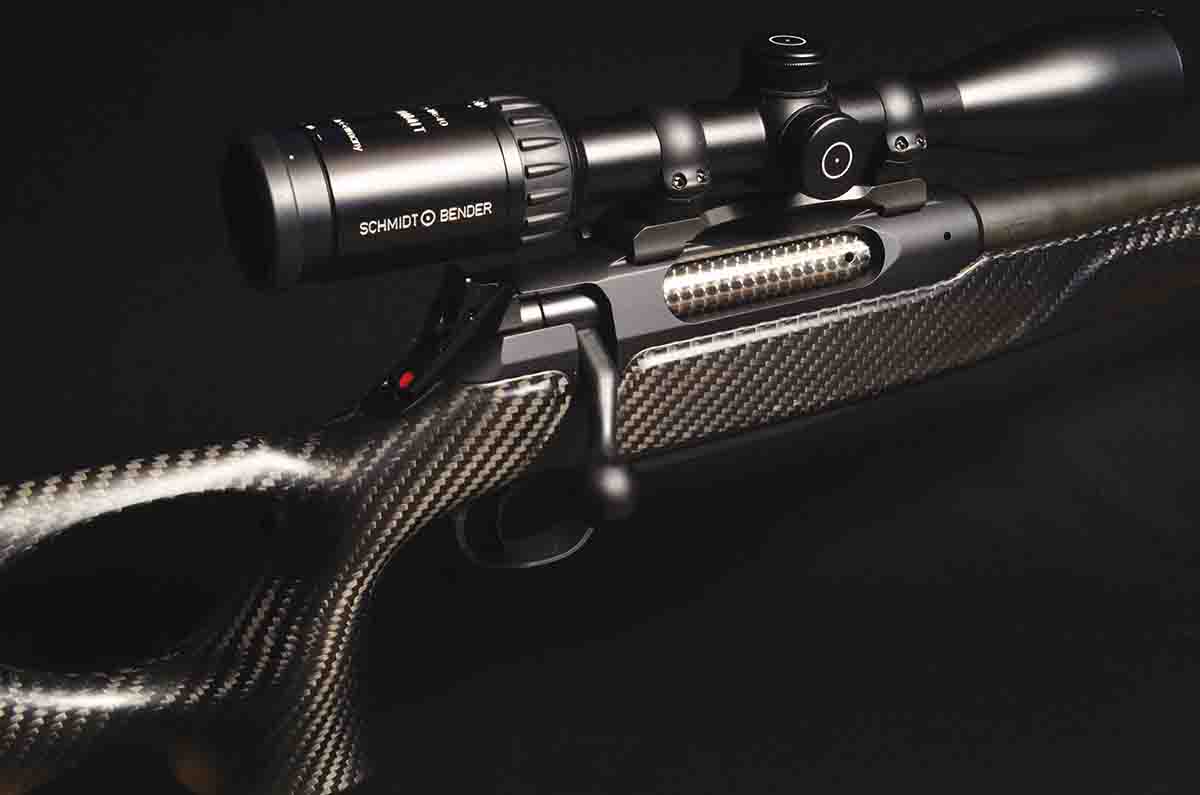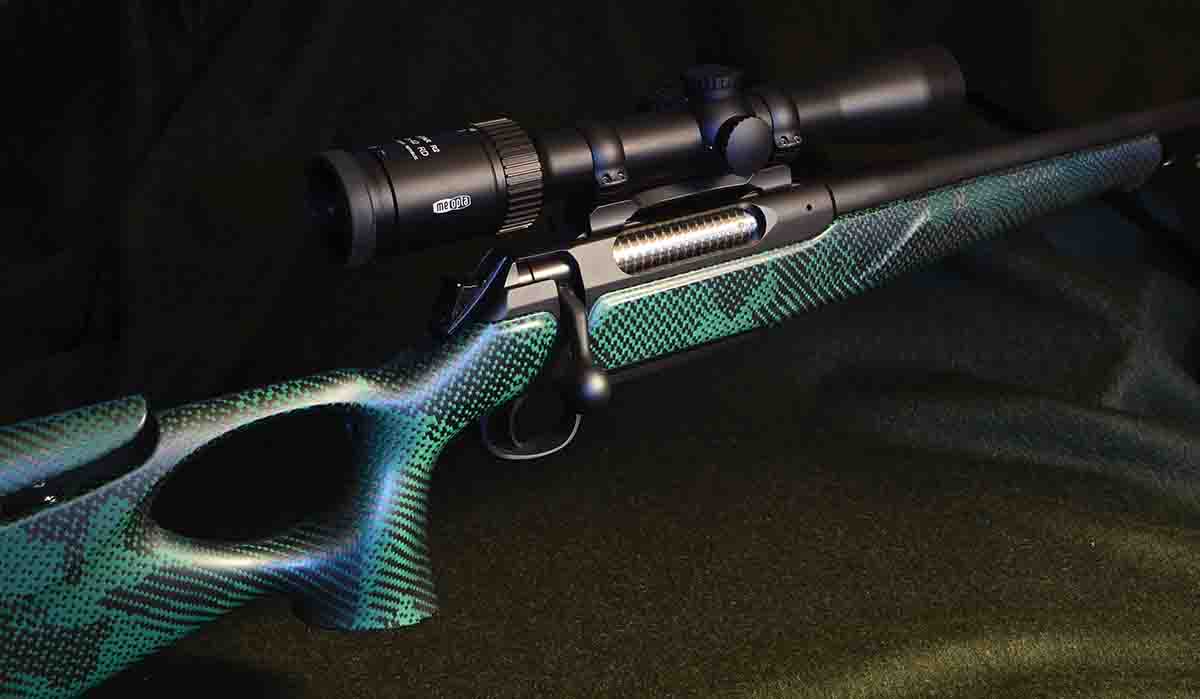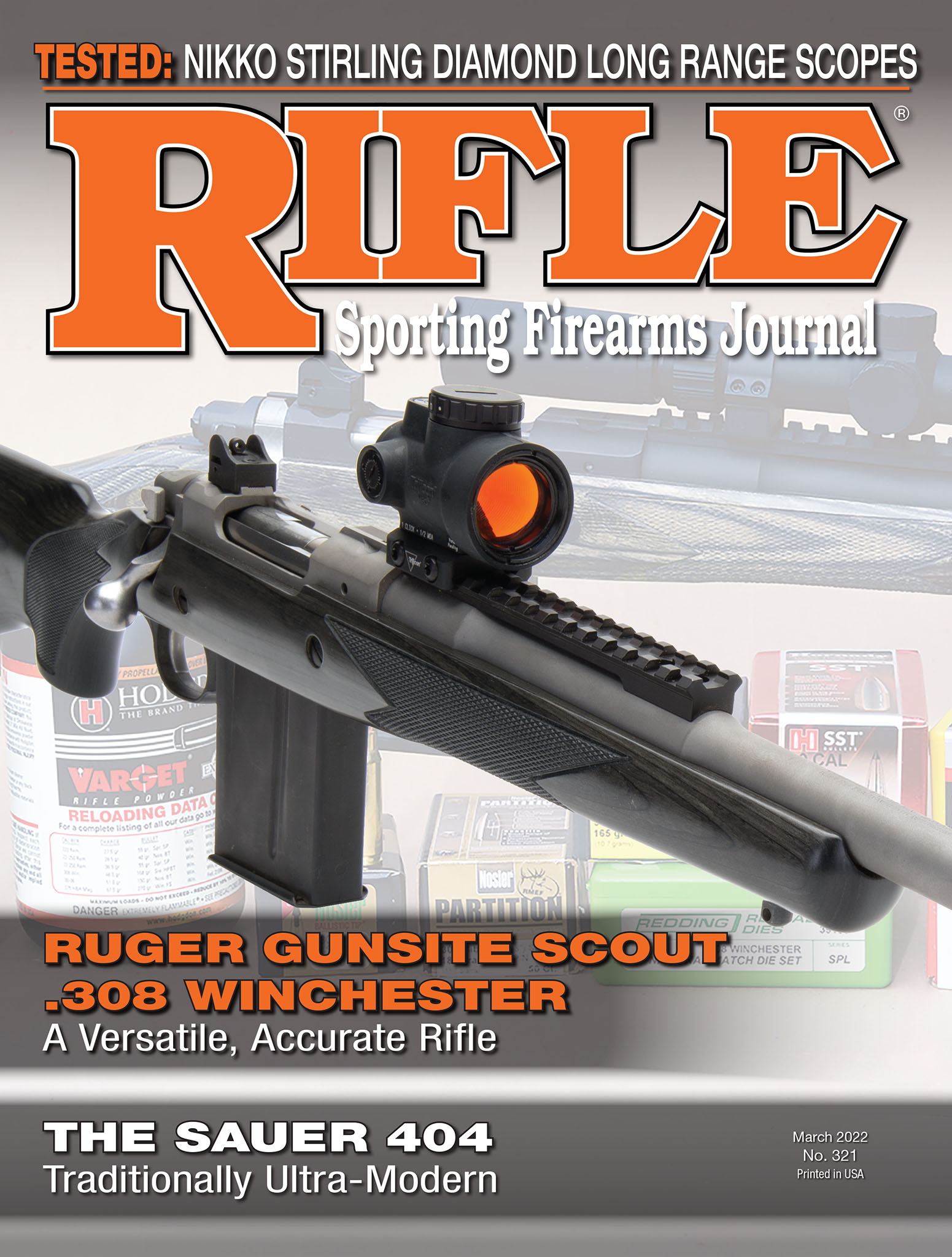Traditionally Ultra-Modern
The Sauer 404 and Its Saurian Stock
feature By: Terry Wieland | March, 22



But survive it did, and it did so by making a wide variety of military and sporting weapons. Among its products were some beautiful drillings (three-barrel combination guns) made for the Luftwaffe as survival weapons during the 1930s, and these

Around 1880, Sauer pioneered the production in Germany of machine-made hunting rifles with interchangeable parts. Today, the company produces a line of bolt-action rifles that combine innovation and ultra-modern production methods (CNC machines, cold hammer-forged barrels) with traditional craftsmanship. Sauer thus manages to be, at the same time, both traditional and modern.
The only gunmaker older than J.P. Sauer is Beretta, founded in 1526. For many years, John Rigby & Co. claimed to be the second oldest, but its supposed founding date of 1735 was an error – a perpetuation of a misprint that was supposed to be 1775 – and this was never admitted until Rigby found itself under the same corporate umbrella as Sauer and Mauser, comprising the Blaser group of companies.
The reason I mention all this is because the Blaser group is operated unlike any other gunmaking conglomerate I’ve ever heard of. Blaser, Mauser, Sauer and Rigby each have their niche products, yet they operate more or less independently, and even in competition with one another. At the corporate headquarters in the town of Isny im Allgäu, in the German state of Baden-Württemberg, Blaser, Sauer and Mauser have separate buildings (although they do share some operations, such as barrel making). John Rigby, of course, is located in London.


The latest Sauer model is the 404, which has been around for several years now, but the company keeps coming out with new wrinkles, upgrades, different stocks and new calibers. The one seen here is the Model 404 Synchro XTC which is, dare I say, just about the best-looking iteration of a composite stock I’ve ever seen – and its handling is as good as its looks.
I never thought I would say that being a fiberglass hater (or at least skeptic) since I encountered my first one in the 1980s. I have also never been a big fan of thumbhole stocks, but this one simply works and works well. Everything about it is ergonomic in the true sense of that often misused word, with a single exception: With no checkering or similar rough surface to aid in gripping, it’s quite slick. This is especially true with wool gloves; leather gloves, on the other hand, stick to it like glue. Problem solved.

It has an adjustable comb which is tightened with a small Allen key incorporated in the rear sling swivel. Similarly, there is another key incorporated in the forward swivel that Sauer describes as its “universal” tool for all the adjustments necessary, including changing barrels, taking down the rifle for storage and so on. The ingenuity of these tools requires a word. With a sling attached to both, they would be almost impossible to lose – a continuing worry with such features – but they also make the sling instantly detachable, accomplishing many functions in one.
Although it’s a thumbhole design, the stock is completely ambidextrous and just as comfortable for southpaws as for the right-handed shooter. The same is true, obviously, of the cocking slide – something that is notably untrue of virtually all safety catches on conventional bolt rifles.
Another intriguing feature of the 404 is the ability, using the universal tool, to remove the buttstock in order to make a shorter package that can be stowed in a backpack, for when climbing a mountain or coming back down carrying a chamois. Americans don’t normally hunt that way, but Austrians and Germans certainly do.
The 404 is modular. By switching barrels, magazines, bolt heads and stocks, a hunter can turn a .243 Winchester small-game rifle into a .404 Jeffery Cape buffalo gun and back to a long-range 6.5 Creedmoor, all in a few minutes.

The 404 employs Sauer’s own design of a quick-detachable scope mount. These are available in both one inch and 30mm, which allows multiple scopes for one rifle, or a different scope for each barrel. Switching barrels does not affect the zero, so the shooter is not required to hit the range to re-sight every time. (Personally, I would want to check it every time anyway, especially if I was going hunting, but that’s me.)
The rifle uses the now common (in Europe) manual cocking system. A slide on the bolt shroud cocks the rifle when it is pushed forward and uncocks it when pulled back. In the uncocked position, the bolt is locked. Shooters can release the bolt to unload by pushing the slide forward a fraction of an inch. This system is also used by Blaser on its R8, and neatly solves all the problems of bolt actions being loaded, cocked, and the requirement for three-position safeties, or (cheaper) two-position safeties that don’t lock the bolt.
When shooting – firing a shot, working the bolt, firing another shot – the rifle stays cocked. In other words, you don’t need to utilize the cocking slide for every shot. Once finished shooting, de-cock it, and the rifle is “safe.”
The biggest factor in accurate shooting, whether it’s a rifle, pistol or shotgun, is trigger pull – not just the weight, but how crisp the trigger is, and whether it’s in the proper position for the shooter to control it. With its Quattro trigger, Sauer has again broken new ground. Using the universal tool, the shooter can change the position of the trigger, moving it forward or back (up to 8mms, or .3 inch), and even canting it to the left or right (up to 5 degrees) to make sure the trigger finger is right where it should be. Combined with its pistol grip, the ideal hand position is achieved effortlessly, every time.
The trigger pull weight can be changed among four positions: 1.2, 1.7, 2.2 and 2.7 pounds. These may seem light, but coupled with the positive qualities of the cocking system, it provides for very exact shooting, and the pull itself is as crisp as the legendary SAKO trigger of old.
Historically, “switch-barrel” rifles have not been noted for pinpoint accuracy – although, in my experience, this criticism is leveled at all such rifles regardless how they actually perform. The problem, of course, is the method of attaching the barrel: How tight it is and how tight it will stay through prolonged use. The Sauer 404 barrel is locked in place with three clamping bolts that hold it like a vise.

Admittedly, this is not as simple as slipping a catch, rotating the barrel and pulling it out, like the old Savage 99 takedown system, but it’s a galaxy ahead in terms of solidity and repeatability.
In today’s world, a rifle can have all of the above features, but if it isn’t accurate, it gets a failing grade.
I spent several range sessions shooting the 404 and my experience is worth recounting. The first time out, the rifle was not as accurate as I expected it to be. It turned out that I had not fixed the barrel in place properly. With all the bolts properly tightened, the groups did, too.
Another problem was the detachable magazine popping loose and dropping down about a half inch, but only when there was just one round left in it. To clarify, the magazine holds three .270 Winchester rounds. Filling it, chambering a round, firing – no problem. Chambering a second round, firing, the magazine popped loose. Firing the third round, again, no problem. I took the rifle to Blaser in San Antonio, where Blaser’s gunsmith, Andrej Gorjup, adjusted the locking mechanism. I also got a spare magazine to try. On the next trip to the range, everything worked to perfection.
There are two points to be made from this. One is the importance of having access to specialists who know these rifles and can work on them. Blaser, including Sauer and Mauser, have this facility available and the problem was solved.
The second point is the importance of thoroughly testing a rifle before getting on the plane to Alaska or wherever. The malfunction occurred under very specific circumstances. Had I shot the rifle loading one round at a time, I never would have noticed.

By the way, the release button for the magazine has a “locked” position so it cannot be accidentally released, but the button was not the problem. I would never – repeat, never – go hunting, especially in far-off climes without access to gunsmiths or replacement parts, without a spare magazine. This is a lesson learned over many years, and I share it with readers.
Moving along, how accurate was the rifle once everything was working smoothly? Very accurate indeed. An accompanying photograph shows a group fired with Norma 150-grain Oryx ammunition, which was the most accurate of those tested.
Using five different factory loads and two handloads, I found the rifle liked three of the four factory loads well enough that I would hunt with them without a second thought. It did not like low-recoil practice loads at all (either factory or handload) and my own favorite, developed for a custom .270 with which I’ve hunted for five years, was okay but not great. Given the rifle’s proven ability to shoot well, however, developing a precision handload should not be too difficult.
The Sauer 404 XTC is not cheap. In fact, by any standard it is one expensive rifle: The list price on the one I tested, with the green carbon fiber stock, is around $10,000. Immediately, one might say that such a rifle should come absolutely trouble free, and you’d be right. The puzzling problem with the magazine might have been the result of someone fiddling with the rifle before I received it, since it had been sent to other writers for testing. Who knows? The problem could not be duplicated in the shop and only occurred on the range, with one round left in the magazine, using full-power loads.
One thing for certain, though, is that Sauer had the knowledge and facilities to correct it as soon as I told them about it, and that counts for a lot.
I mention all of this travail purely in the interests of full disclosure. Would I like to add the Sauer 404 XTC to my rifle rack? Absolutely. Would I go hunting with it tomorrow? Again, absolutely. It is every bit as good as one expects a J.P. Sauer & Sohn rifle to be. After all, they have 270 years of experience at this stuff and that counts for a lot.



.jpg)